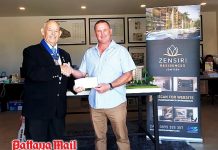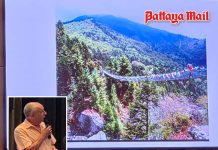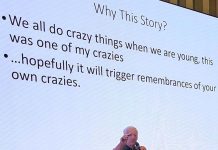Cuba has a rich and colorful history; this was the message at the Sunday, February 26 meeting of the Pattaya City Expats Club. Master of Ceremonies Richard Silverberg called on Linda Cruse to introduce Ivan Sanchez, a native of this island nation. Ivan is a young man enjoying his first travels outside of Cuba. He has recently visited India and Nepal and is currently visiting in Thailand and agreed to tell the Club something about his native country.
Ivan began by describing Cuba’s location and summarizing its history from when it was discovered in 1492 by Christopher Columbus to the present day. To the north of Cuba is the United States, about 90 miles away; to the west is the Bahamas and Mexico; to the south is Jamaica and to the southeast are Haiti and the Dominican Republic. Since Christopher Columbus claimed Cuba for the Kingdom of Spain it was a colony of Spain for about 400 years. This came to a close when the Spanish American War ended in 1898. Cuba is well known for its fine cigars, salsa music, and sugar cane.
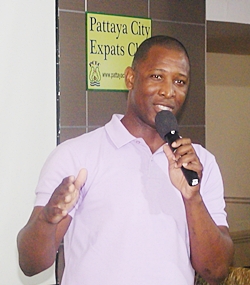 Ivan Sanchez, a native of Cuba, discusses life & growing up in Cuba under the communist regime. Ivan is enjoying his first trip outside Cuba, & shared with PCEC members the interesting history of Cuba from its discovery by Columbus in 1492, to the present day, including the Cuban missile crisis, and life under Castro.
Ivan Sanchez, a native of Cuba, discusses life & growing up in Cuba under the communist regime. Ivan is enjoying his first trip outside Cuba, & shared with PCEC members the interesting history of Cuba from its discovery by Columbus in 1492, to the present day, including the Cuban missile crisis, and life under Castro.
Ivan pointed out that in 1511, the first Spanish settlement was founded at Baracoa and in 1515, the future capital of San Cristobal de la Habana was founded. At the time Columbus landed on the island, there were two groups of indigenous Indian people; the Taíno who were farmers and the Ciboney who were primarily fishermen and hunter-gatherers. The Spanish enslaved most of the indigenous people, setting them primarily to the task of searching for gold. Within a century the indigenous people were virtually wiped out. To maintain a source of labor, the Spanish colonist brought any many slaves from Africa.
After the Spanish American War, Cuba was under the control of the USA until it was granted independence with restrictions in 1902. Ivan described the economic situation and culture of Cuba, especially its music. He mentioned the events that led up to Fidel Castro’s revolution and setting up of the current Cuban government. Because of the US embargo, Cuba was aided by several socialist countries. However, with the fall of communism around the world, this support came to an end in 1991. For several years thereafter, living conditions in Cuba were horrible. There was a shortage of many items and because of rampant inflation, what was available was extremely expensive. As an example he mentioned that they couldn’t even buy soap to bathe with; but with necessity being the mother of invention, they came up with a plant that could be used instead. Likewise, they made do with substitutes or did without.
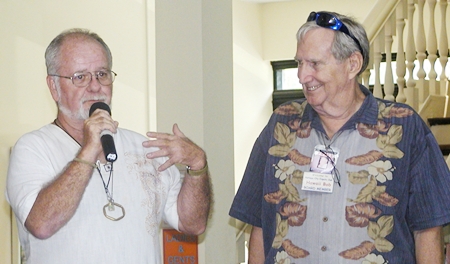 Member Jerry tells PCEC members of the activities of the Pattaya Friends of Youth, whose aim is to enrich the lives of many of Pattaya’s less fortunate children. Fishing trips and shopping trips (for Christmas) are some of the recent activities. Board Member Hawaii Bob looks on.
Member Jerry tells PCEC members of the activities of the Pattaya Friends of Youth, whose aim is to enrich the lives of many of Pattaya’s less fortunate children. Fishing trips and shopping trips (for Christmas) are some of the recent activities. Board Member Hawaii Bob looks on.
He then explained how this downturn in the Cuban economy led to the promotion of tourism as a way to obtain needed money. Things in recent years have improved. Ivan then showed a video called, “Moments in Cuban History.” It showed many historic places in Cuba as well as Cuban’s going about their lives and enjoying music and dancing. Of keen interest to many in the audience were several pictures that showed “vintage” American cars from the late 50’s and during the question and answer period, several in the audience mentioned how remarkable it was that many looked almost in mint condition.
In response to the question of whether it was difficult for him to obtain a passport for travel, he responded that it was not so much difficult as bureaucratic. He said there was a lot of paperwork and many visits to various offices involved in the process. Further, since passports were issued by the military, they sent people to where you lived to make inquiries about you. Although it took time, he was able to obtain his passport and has been enjoying his time traveling and seeing some of the world, but he does plan to return to Cuba at the end of his travels as it is his home.
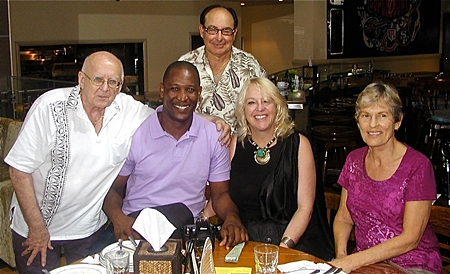 Ivan and his mentor, Linda Cruse pose with PCEC members Les, Nathan and Pat.
Ivan and his mentor, Linda Cruse pose with PCEC members Les, Nathan and Pat.
Master of Ceremonies Richard Silverberg called on Roy Albiston to conduct the always informative Open Forum where questions are answered about expat living in Thailand, recommendations made about movies and restaurants, and occasionally the telling of a joke or two. The Pattaya City Expats Club meets every Sunday at the Amari Orchid’s Tavern by the Sea Restaurant. Read more about the Club’s activities on their website at www.pattayacityexpatsclub.com.


